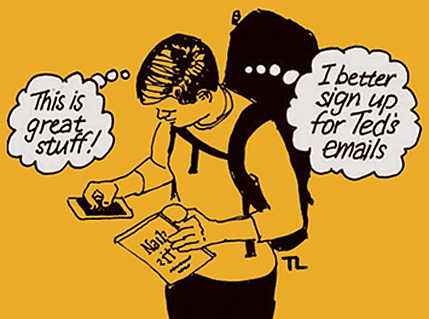Networking online is scary

“It felt like a knife through my heart.”
This from a client of mine who’d just had four people unsubscribe from his email list.
Or this one from another client: “Every time she posts another success on Facebook, it feels like success is impossible for me. It’s as though her success is a direct result of my failure.” She goes on to tell me that she knows she’s being irrational. That she knows others’ successes don’t mean she’s a failure. But in her gut they do.
Networking was tough enough when, “Hi, my name is: Ted” was pasted on my chest. With Covid, we don’t have the little human cues of place and a shared coffee to build the emotional bridges we count on to ease us into a new connection.
Coffee dates with mentors and colleagues. Drinks with co-workers after work. The pleasure we get from those little human interactions… all gone. So here we are, with the fear of networking increased while the networking opportunities have been reduced.
Start
Know why you’re scared, and understand the fear.
Personally, I’ve found that my networking fears are not much different from pre-virus days: I’m afraid people will think I’m desperate, and that they’ll think I’m needy.
Worse, even before I focus on what others will think, I start downgrading myself by thinking that I’m really not very good. My tech skills aren’t up to snuff. My past successes were flukes. I really don’t have much to contribute.
Is that enough of a disincentive for you? Here I am writing this for you, and believing every inner word about my own failings as I write it. Hmm… sound familiar?
Plan
Okay, time to overcome that self-doubt. First I know I must make a plan. Why a plan? Well, I know from extensive experience that if I want to get a job, advance myself in my existing situation or find freelance work, I need to find a systematic way to connect with people who can help me.
So start with what you already know about networking. My guess is you already know quite a bit about your community, and the tools available for reaching them.
First, think about the tools
In the virtual networking world, I have experience with online video conferencing—Zoom, Skype, Facetime and Google Hangouts—and of course email and texting. I also have accounts on Twitter, LinkedIn, Facebook, Instagram and Pinterest. And I belong to several professional organizations, all of which are doing things online.
You may have more, or less, experience with these and other virtual networking tools. That doesn’t matter. What does matter is the mental exercise of reminding yourself of your familiarity with virtual networking channels.
Make a list of all these avenues of connection. This list will reduce your fears by demonstrating your already-comfortable options to yourself. It’s a simple matter of engaging your frontal lobe, to overcome that ever-present lizard brain.
The people
Then make an email list of all the people you know who can help you. As you’re making that list, work through the mental exercise of reviewing your past interactions with each of these individuals.
Did you work together for an employer? Share a freelance client? Go to school together? Or do you share a skill, or membership in an organization?
What’s important here is your memories of these individuals and your connections to them. Those memories will lead you to your strategy, and to finding what you need.
Confidence
Make your lists on a spreadsheet or with pencil and paper; doesn’t matter. What does matter is the mental exercise of remembering your experience with both the people and the tools you’ll use to connect with them. This step is about gaining confidence.
Remembering successful past connections provides a source of assurance that you’ll be successful going forward.
Connecting with individuals
From your list of people, pick out four or five you think have the most ability to help you. Then, with the first person on the list in mind, write your ask statement.
I’d recommend something completely honest, like…
“Hi Arianna, it’s been awhile. With the coronavirus, I’m missing the professional connections that used to keep us in touch. I’m looking for work, and I’d like to kick around some ideas with you. Got time for a Zoom talk? I’d love your insights and advice!”
Okay, what “ideas” am I referring to? First would be thoughts on employment, contract or freelance opportunities. Second would be questions about where Arianna thinks my skills might be a fit. Notice that I’m asking for “insights and advice,” not a job or a gig. I don’t want to make Arianna uncomfortable by putting her on the spot.
What not to say
I get “How are you doing?” or “How are you holding up? from people I barely know, or don’t even know, at least once a day. Or I get the similar “How are you adjusting to the current situation?”
Don’t do it. It rings of false intimacy. Or it feels condescending, as in “poor you.” I haven’t asked for their help or their fake sympathy, and I don’t want it—and I bet no one else does either.
Connecting with groups
As I work through my memories of interactions with the people on my list, I might hit on an entire group of people my skills might help – a group I could send a common appeal for help to. People who would all benefit from my skills and experience. Notice that I’m way past my fear of rejection, now that I’m into planning my networking effort.
Just as I was writing this article, I got a LinkedIn email alert from a connection. She made a group appeal that resonated with me:
“Hi, Ted. As an independent publisher and audiobook narrator, I’ve been asked by a number of authors how they can publish their own audiobook—everything from narration to distribution.
I’m thinking about designing an online community of authors interested in learning about audiobook creation and marketing. Is this something that you as an author would be interested in? All the best, Caroline”
In my experience, Caroline’s message is the best way to connect with a group. She’s using her skills to help me, and others like me. I immediately sent her a reply saying I’d like to be a part of her group, and I asked her if she’d be okay with me using her message in this article. She replied…
From Caroline Doughty …
“Hi, Ted. Yes, I would be honored! I’m new to this online networking, and am finding that this particular message has been most effective. I changed the last line in this note, basically asking for simple yes or no answer, and have had great responses, either expressing interest or thanking me for asking, but no ‘not interested.’ Thanks, Caroline”
With the inspiration from Caroline, I sent a note through Facebook to Damon Buxton, a musician I know who markets his music online, asking him how his virtual networking is going, and he replied…
“Pretty good––mostly what’s working is people discovering me on Pandora or Spotify without my doing anything. But staying in touch and talking with industry people via FB & Zoom is helping line up potential future concerts.”
Picking up on previous connections without the benefit of face-to-face interaction is not as hard or as scary as we tend to think it is.
In review…
-Understand your fears
-Draft a simple plan
-List the networking tools you’re familiar with
-List the people who could help; compile an email list
-Draft a message that asks for help
-Consider building an online community as Caroline and Damon have
-Launch your effort.
-Review results and modify as needed
Finally
There actually is one bright light in this tunnel of despair: This is a time when we all need other people’s help. We’re living through a global catastrophe—a catastrophe we all share. And so there’s never been a better time to network virtually.

